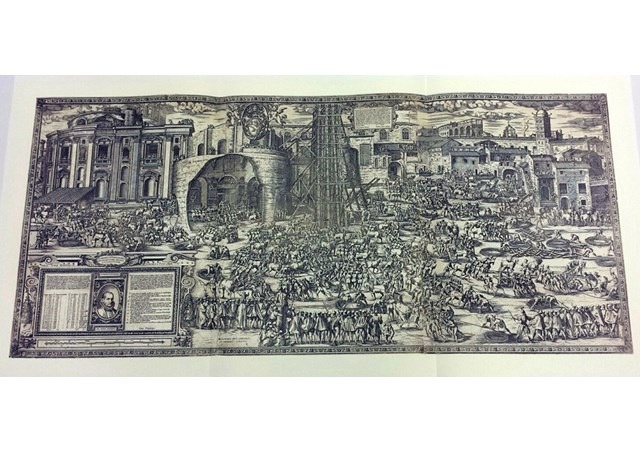
Pope Francis gives print of obelisk to UN offices

(Vatican Radio) Pope Francis presented the offices of the United Nations in Nairobi, Kenya, with a gift on Thursday: a print showing the raising of the obelisk that stands in the middle of St. Peter's Square. The Holy Father presented the gift during the course of his visit to the offices on Thursday, November 26, 2015, the first full day of his three-country visit to Africa.
Please find a description of the article, below
***********************************************************
Natale Bonifacio (Sebenico 1538 – 1592) Engraver
Giovanni Guerra (Modena 1540 – 1618) Inventor
Erection of the Vatican Obelisk
Lithograph
1586
Inscriptions: in the lower left: Disegno nel quale si rappresenta l’ordine tenuto in alzar la Guglia il di ultimo d’Aprile MDLXXXVI (…) sopra: DOMENICO FONTANA DA MILI DIOCESI DI COMO ARCHIT. E CONDUTTORE / In Roma Natal Bonifacio de Sebenicco Fece. D’Agosto 1586. In basso al centro: 10 GVERRA MVT. LINEAVIT ET IMPRIMI. CURAVIT.
In the Spring of 1586, Sixtus V taking advantage of the genius and organizational qualities of Domenico Fontana (1543 – 1607) undertook the moving of the Egyptian granite obelisk, that was situated on the southern side of the Basilica, and relocated it to the center of the square in front of the Basilica itself. Among the tallest of the Roman obelisks, second only to that of the Lateran, it was brought from Egypt at the time of the Emperor Caligula and raised in the circus of Caligula and Nero across the Tiber, where St. Peter was martyred. Other pontiffs had yearned to tackle the challenge, but it had never been undertaken because it was thought to be impossible. Sixtus V invited architects, engineers, artists and scientists to present a project, but in the end decided on his own to assign his trusted architect, Domenico Fontana.
The endeavor lasted from Spring to September of that year, and involved the demolition of some apartment buildings for the transport of the monolith from the place where it was to the center of the square, and the implementation of 38 pulleys, 900 men and 75 horses.
The enterprise is documented by two large and beautiful prints, including the one under observation, published in August of 1586, when the operations were still underway, and then successively, in 1590, in the volume “Della Trasportatione dell’Obelisco Vaticano e delle Fabbriche di Nostro Signore Papa Sisto V…(Of the Transportation of the Vatican Obelisk and of the Factories of Our Lord Pope Sixtus V) published by the Vatican Typography directed by Domenico Basa.
The print shows the status of the operations in the month of August but above all, it is an ample representation of the state of the Basilica and of the surrounding areas at that date. The richness of the details and the numerous captions and inscriptions make of it a work of much artistic value but at the same time descriptive and celebratory of the event. The print bears the crest of Sixtus V, the portrait of the author of the famous translation, the architect Domenico Fontana, and many other details.
The authors of the large engraving, in three tables, are Giovanni Guerra, who is responsible for the invention of the composition (as well as for the realization of a fresco on the same theme in the Sistine hall of the Vatican Library) and the engraver Natale Bonifacio. The first is counted among the protagonists of that “Sistine” style that in the years of the pontificate of Pope Peretti decorated the immense architectural works built. Natale Bonifacio instead was a Dalmatian engraver who worked between Venice and Rome, achieving recognition as a vedutista but above all as a cartographer.
| All the contents on this site are copyrighted ©. |


